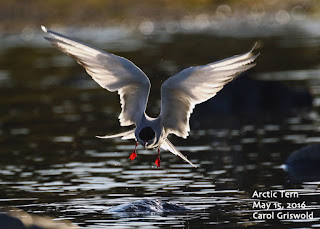Seward, Alaska
Eighth sunny day in a row!
Sure seems like summer!
This morning, I visited Exit
Glacier in Kenai Fjords National Park. It’s so easy to go, I often forget
there’s a spectacular national park virtually in my back yard. My target
species were the NORTHERN WATERTHRUSH, SWAINSON’S THRUSH, and GRAY-CHEEKED
THRUSH.
After I drove over the
Resurrection River Bridge marking the park’s boundary, I heard the NORTHERN
WATERTHRUSHES calling from the willows and alders near the wetlands alongside
the road. I parked and walked, looking in vain for this loud ventriloquist. My
main bird remained hidden in the dense thicket as he rhythmically called and
listened for the responding Waterthrushes, never moving to reveal his location.
A nearby ORANGE-CROWNED
WARBLER was easy to spot as it flitted through the spruce, willow, and
cottonwood trees. YELLOW-RUMPED WARBLERS proved harder to spot, but sang their
slow warble near the creek.
Traffic was surprisingly
light, so I could drive slowly with my windows open, listening to more
Waterthrushes singing along the road as long as there was water nearby.
Birdsong continued in the
parking lot. I chose the 0.4 mile walk on the paved path to the Outwash Plain.
In the distance, I could hear the upward spiraling song of the SWAINSON’S
THRUSH. Yea! I soon located the songster at the very top of a leafy cottonwood.
He also sang and listened, as another Swainson’s responded in turn, a beautiful
duet.
WILSON’S WARBLERS sang their
rapid “sewing machine” song all along the path. Just past the shelter and
junction to the Edge of the Glacier path, is a nice grove of willows. A YELLOW
WARBLER flashed from tree to tree, a little yellow tropical splash, singing his
little heart out.
I walked to the start of the
outwash plain where I once heard a Gray-cheeked Thrush. No luck this time.
Turning back, I then took the
Edge of the Glacier path (formerly the Nature Trail). Exit Creek is fairly loud
along the trail, making it hard to hear the birds, but the view of the glacier
is excellent. Once the creek is left behind, the birdsong returns. I traced a
loud, rapid drumming to a little DOWNY WOODPECKER. He had found a perfect drum,
an old, dead cottonwood.
Throughout my walk, I also
heard VARIED THRUSHES, ROBINS, HERMIT THRUSHES, RUBY-CROWNED KINGLETS, a
BLACK-CAPPED CHICKADEE, and more WILSON’S, YELLOW, ORANGE-CROWNED, and YELLOW-RUMPED
WARBLERS. I did not hear the other common warbler, the Townsend’s.
I recorded many of the bird
songs using the video option on my point-and shoot camera. A smart phone
recording would work as well. Playing the recordings later is a great way to
review and remember the songs. A plus is the video of the habitat, and if you’re
lucky, a glimpse of the bird singing.
Go early if you can to beat
the noisy crowds. If you can’t go early, go anyway. The birds sing all the time
and often there are breaks in the people parade. I expect this concert will
continue until early to mid June and then it will diminish as nesting and
family duties intervene.
The glacier is still impressive and there’s always something interesting to see no matter when you go. Visit
YOUR National Park soon!
Happy Birding!
Carol Griswold
Seward Sporadic Bird Reporter

























































